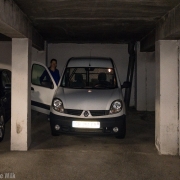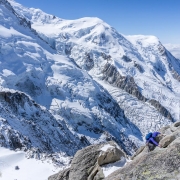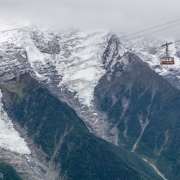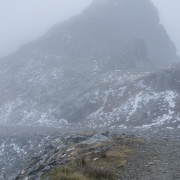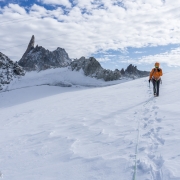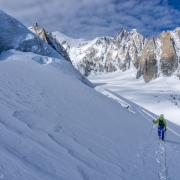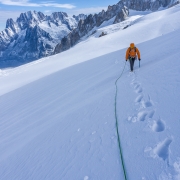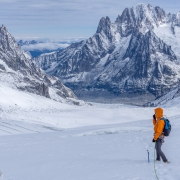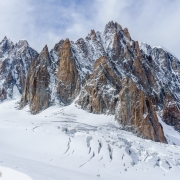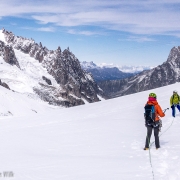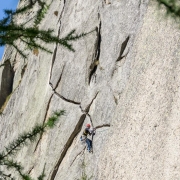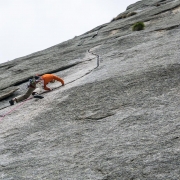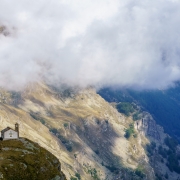
September 5-20, 2017
After the great work trip to Chamonix I had in May I started thinking about going back and having more time for climbing and seeing the valley. After some asking around it sounded like September was a good month to go as the weather was still mild and the summer tourists had gone. So Carly and I planned a trip for September.
The trip caught the tail end of a Labor Day visit to New England for Carly and I to see family. That trip was pretty good seeing her family and mine, as well as the new addition of my nephew. Seeing New England again reminded me that it was a nice place to live and quite scenic, but not grand like the West typically is. While we did get to climb at Cathedral Ledge one day, which is one of my favorite crags, the landscape is just not all that exciting. I was reminded at Cathedral that North East grades are stiff! A scenic flight around the Rangeley area reveals a lot of hills, lakes, and perhaps something you could pass off as a mountain, but not really. I’ve now taken off in an airplane from land, snow, and water. Still on the list is dirt/sand, and perhaps a real stretch would be boat.
Leaving from Boston in a seafood and lobster coma, I headed straight to Chamonix. Carly would head back to SLC for a few days before coming out to France. I went from the Geneva airport to some work related activities in Chamonix. Being at the mothership was good to catch up with people there, but I was really looking forward to getting into the Air BnB we’d rented in downtown Chamonix.
The day Carly arrived it was pouring. Thankfully I’d secured the use of the company vehicle, a Renault Kangoo. The van is a tiny cargo van not a passenger car. As such it comes with ammenities such as: four wheels, brakes, seats, steering wheel, all the accoutrements. Things I found out that it does not come with, good tires, nor anti-lock brakes. The numerous roundabouts in driving rain in Chamonix were where I found these exciting omissions from the Kangoo’s feature list.
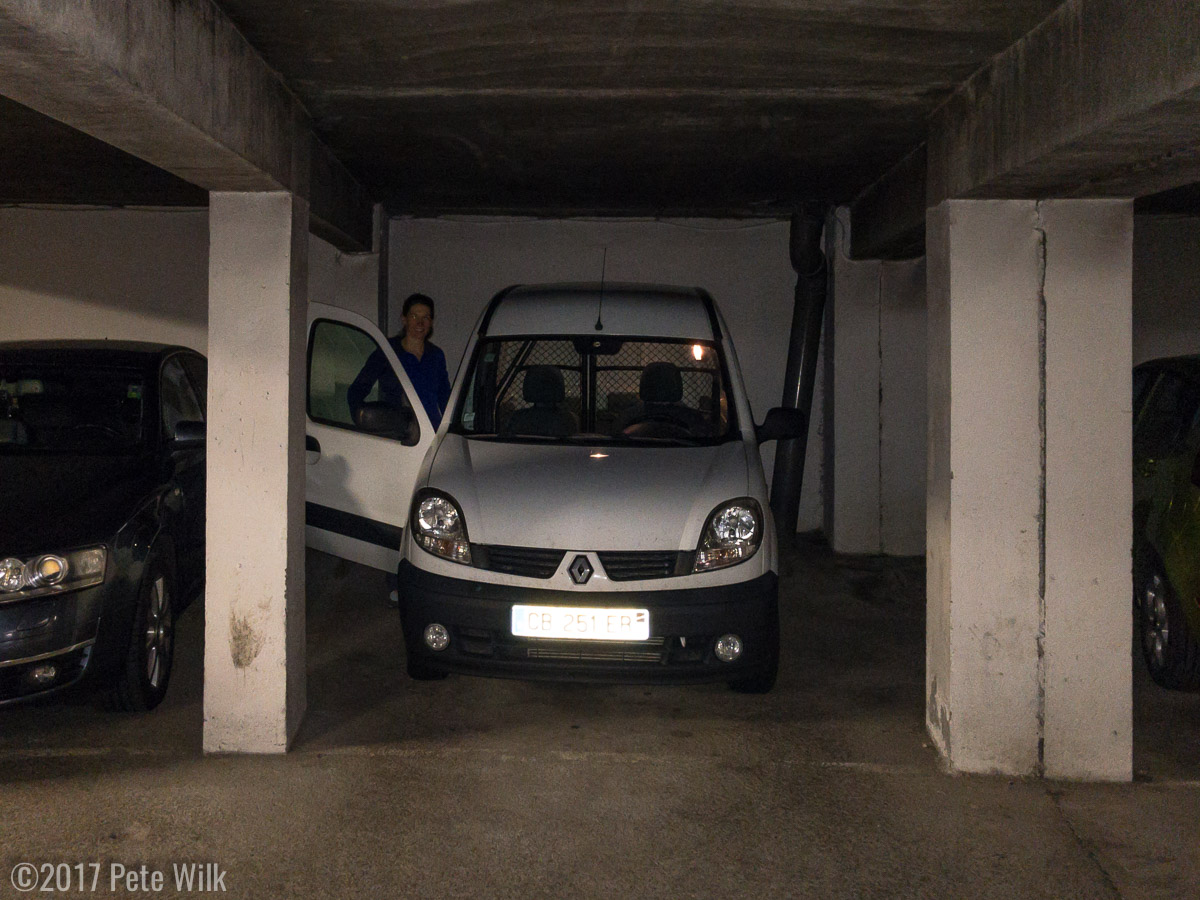
With us unpacked in our 5th story studio flat and the Kangoo parked in an underground parking structure so low that I instinctively ducked when I walked under the support beams, we were ready to explore the town. From our vantage point we had a great view down valley and could see the sun set against the mountains. Luckily Chamonix downtown is small and can be walked in 10 minutes or so. We were lucky in that we had a number of great food options just a block from our flat.

The day after Carly’s arrival we slept in and headed to a crag a few villages up valley from Chamonix. The crag was nothing super special, but it got us out for a hike and we were able to do a 5 pitch route of well bolted slab climbing. The views were good, even though there was a mid elevation cloud layer that obscured the high mountains. We were treated to a very close encounter with a chamois, a mountain goat native to the area. He walked very close to us with little concern for our presence, to the point it was uneasy. We moved off the climbers/animal path and he walked on by and posed for a few photos.
The following day the weather looked good so we headed up the Aiguille du Midi téléphérique. Our objective was the super classic Arete des Cosmiques. Though I had done this in May the route is so classic it is an obvious choice to do again, particularly to warm up for other things. The day started off splitter and we casually made our way to the base of the route. A pair of Brits also started up about the same time. The route was more rock than last time and we leap-frogged with the Brits along the beginning section. As we got closer to the crux a team of Russians passed us. This wasn’t all that bad, except the leader thought that Carly and I were good terrain features to use as part of a running belay. I had to fix this, though not without a rebuke in broken English from the leader. I indicated that we weren’t part of his terrain belay, the rock was.
Since we were making good time we took a short break to let the Russians pass and have a bite to eat. We also let the original Brit party we’d been leapfrogging past us as well. As we finished up we could see there was a clog forming at the crux pitch. A party we hadn’t seen was waiting behind the Russians and the Brits in behind the new party. Our splitter day at this point started to fall apart. Some clouds started coming in and along with it a bit of wind from the Chamonix side. Waiting just a bit away from the actual queue we were blocked by some rock formations and could watch in relative comfort and disbelief at the mess unfolding.
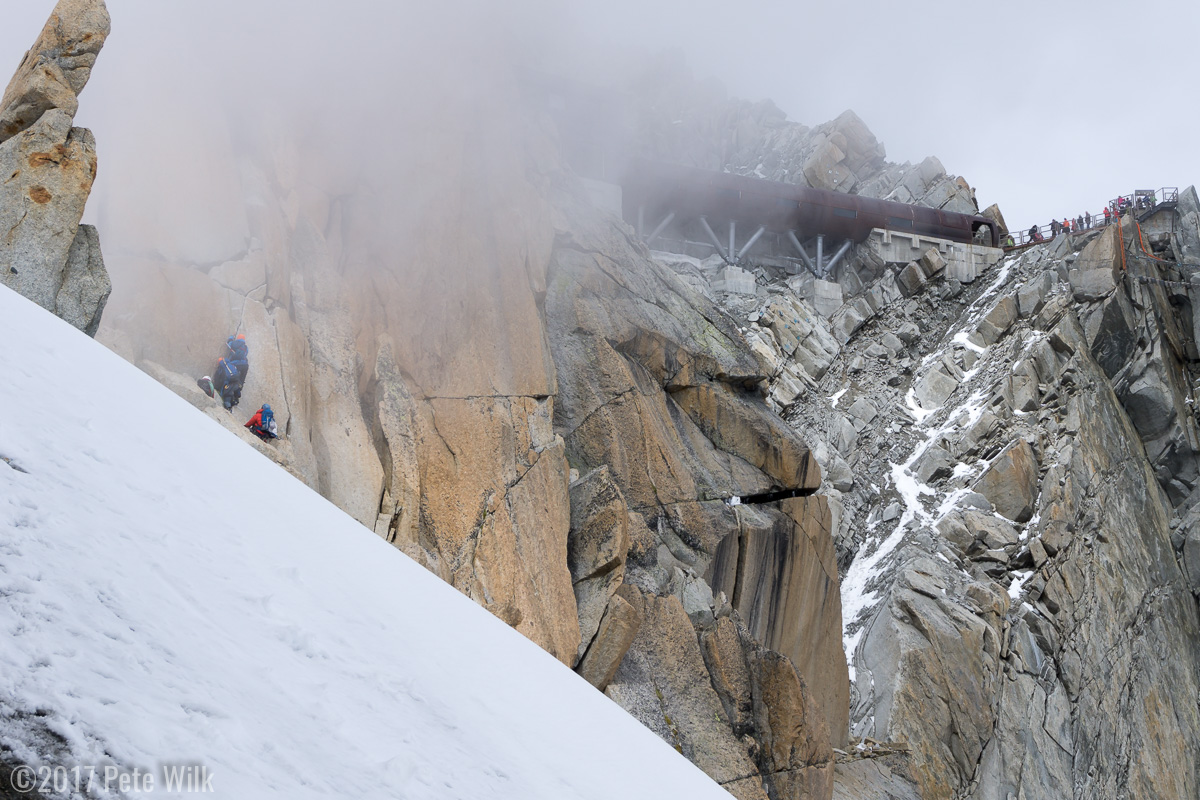
The Russian leader went to the top of the of the crux pitch–approximately 50 ft up. There is an anchor about 20 ft up on a small ledge which is often used with clients since it allows the leader to be just feet away from the client if they have difficulty on the moves. The crux being a right slanting finger crack with bomber footholds which are perfect for crampon points since the rock has “worn” into crampon point shaped divots. However this leader went past that before setting the belay. This complicated the problem that the client had no ability to get through the two moves of crux on his own. Further complicating it, the client had removed his crampons for some reason despite having them on when they passed us originally. The client’s soft boots gave him no edging ability on what natural feet are there. For 20 minutes the client tried to fumble his way through. To help the leader lowered a rope with knots every 16 inches so the client could haul himself though. This also was in vain. Coming on the 30-40 minute mark and now with five parties behind them and coming on 3:40 in the afternoon we queued into position since we didn’t want to have another party skip in front of us. One party went past everyone on a variant to the right of the crux, a tight hands crack about 20 ft long–something to remember in the future. The Brits helped teach the client how to put prussiks on the rope and jug up. Even with a competent user this is a slow process. The clog lasted about an hour, perhaps a bit more. It was worrisome since the last cable car down to town is at 5:30 and we still had approximately 1/4 of the route to go. After the Russians got through the two parties in front of us moved at a reasonable pace. I did forego the mid anchor on the pitch and go straight through since I was confident Carly would climb the crux without much trouble. The remaining parties all made it in time for the second to last car. The deterioration of the weather, the clog at the crux, and the timeline of the cable car all made for a bit more stress than the initial part of the day in the warm sun going at a casual pace.

Evenings were spent going out to dinner at the multitude of choices. We tended to stick with local fare, which is heavy with meat, cheese, and potatoes. Wine was also plentiful and reasonably priced. I would say in general, while Chamonix isn’t a bargain, it is not horribly priced. A nice meal can be had for a little less than 20€ +/- 5€. When alcohol, apps, and desserts are factored in about it was about an 80€ bill for us. Breakfasts in France tend to be heavy on the carbs: baguette, butter, and cheese. We were able to find some places with some protein too.
After the Cosmiques we had a day of cragging in town, walking distance from our flat. This area was basically a city part with a few grid bolted crags. It was quite pleasant. The following day we attempted to get some climbing in at the Planpraz cable car station located across the valley from the Aiguille du Midi. This attempt was fairly doomed from the start based on the weather, but we gave it a try anyway. After one pitch it started to rain and with some snow still on the ground from the previous day’s precip we decided to just hike up to the Brevent station in the rain. It has been a while since I hiked in the rain/clouds and it was kind of nice.

The following day, the 14th, was a total and expected washout. Rain in buckets came all day with cloudbase being less than 2000m. We did touristy stuff all day, browsing the shops, seeing the alpine museum, etc. For lunch we tried raclette, which is a massive chunk of cheese that is melted at the table and accompanied by potatoes and cured meat.
Friday the 15th the weather was supposed to clear enough to get out and do something up high. Maxime was able to join us and we went to the Italian side of the range. To get there there are three options, 1) take the Aiguille du Midi car up and walk across the Vallee Blanc (many hours); 2) drive around the mountains for hours; 3) take the 11.6km tunnel under the mountains (about 30 minutes depending on traffic). The tunnel was our choice obviously. The Italian side of Mont Blanc is a much different environment. While similar in altitude at the base, the plants are very different as the Italian side is drier. The relief is actually even more abrupt since the valley is less broken on its way up to the summit of Mont Blanc. This is all viewed in comfort from the cable car which spins 360 as it goes up.
Our modest objective was the Aiguille d’Entrèves traverse. This climb is a similar ridgeline climb as the Cosmiques. We roped up for our 60+ minute approach to the ridgeline. The previous day had deposited 30cm or more of snow in the mountains. Both Carly and I were happy to have Maxime out in front leading the way across the glaciers. The lean winter, end of summer, and fresh snowfall made from some nearly invisible crevasses. Maxime punched a leg through a couple times, but not badly. Our approach to the climb turned out to be longer than expected and despite the sun rather cold due to the wind. The upside was clear conditions to view the amazing terrain. We had a great view of Mont Blanc and some of the satellite peaks. The terrain for alpine climbing is endless.

After a fairly easy bergschrund we gained the ridge at its low point and racked up. Since Maxime had done the route a few times, he let me leade all the pitches. Carly had the lucky chance to have not one guide, but two–often having a belay from both sides, which is helpful on a knife edge ridge traverse. The terrain was mixed, mostly rock, but with some snowy bits. At no point was a piolet required on the ridge. There isn’t much gear, but in the spots you want it there is some. The only exception to this is a variation which goes up a large stack of flakes. The only moves I saw were 10 feet or so of laybacks with no gear. I gave it a couple up close looks, but decided to bypass around the right. We finished up the climb mostly on our own, there was one party of a guide and two Swedes that we leapfrogged a few times. The climbing was quite enjoyable, but still exciting because of the exposure on either side. View of course were top notch.

We slogged back to the cable car station, but with a quick trip to the Torino “hut” since we had time before the last car. The Torino hut is essentially a hotel on the mountain. We walked into the bar area ordered a beer and slice of pie. Visiting the hut also cut out about ~50m of elevation back to the cable car station as well. When the new cable car was constructed a few years ago they stabilized the supports for the station by drilling a massive hole into the mountain. This hole now contains an elevator which goes down to the level of the hut. As said by Maxime, “The ‘approach’ to the hut can be done in flip flops” as it only requires walking outside for about 50 ft on flat ground.
Our brief weather window closed after this outing on the Aiguille d’Entrèves. The weekend and beginning of the week looked much of the same questionable weather: wind, precip, too cold at mid-elevations. So with the prospect of not much climbing, even at the crags in town, we decided to take advantage of having a car and go a little abroad for the weekend. Actually this decision was a laboriously slow one. With no definitive plans Saturday morning, despite two invites from coworkers, we procrastinated until lunch and then decided to go to Valle dell’Orco. The idea had come from Maxime and Zoe the night before. They’d given us a few guidebooks to consider. Finale seemed like a primo spot to escape the weather, but it was 5-6 hours away and the guidebook was in French. We opted for the closer and in English location, plus it was plugging gear.
We fueled up the Kangoo and headed toward the Mont Blanc tunnel again. This time around we hit some heavy truck traffic and took nearly 20 minutes just to get into the tunnel. Once on the Italian side you travel through what felt like miles of additional tunnels bypassing the quaint towns in the Aosta valley. Eventually turning off the highway we started making our way to dell’Orco.
As most people know August is a popular month for taking vacation in Europe, it would seem that September in some areas is the down season or at least getting ready for it. We rolled into the Valle dell’Orco on a tiny road through the most old, quaint, picturesque, and nearly shuttered villages you can imagine. In Ceresole, the main village near the Sergeant formation, we could only find two open hotels out of the dozen that are on the map. Even the tourist office was closed. We decided to splurge and stay at the Grand Hotel in Ceresole, though the current name is much less grand.

Being outside of relatively cosmopolitan and anglicised Chamonix, our chances of finding good native English speakers was lower. Our first attempts at asking about if there were rooms available and how much they cost was rough. Luckily the hotel worker spoke a little more French than English. Carly and I were able to cobble together some basic inquiries and get some info back that there was plenty of rooms. We opted to get breakfast and dinner included in the price since there weren’t many other options for food anyway. We weren’t completely sure of the price, but we figured our options were limited anyway.
The hotel was quite nice and freshly renovated on the inside, but much of the exposed structure like ceilings and windows were restored and maintained its original look so as not to look modern. Dinner came and with a little help from one of the two hotel managers who spoke more English than the first desk worker, we had an amazing 3 course dinner, complete with a liter of wine. Hey, we weren’t driving anywhere so why not?
Sunday’s weather revealed a bit of snow up in the high mountains ringing the valley. Our objective though was just a minute or two drive down the road, though the approach from the parking area was steep. The crags of Valle dell’Orco are a kind of granite and the primary style as in most granite areas is traditional routes via cracks and bolted slabs. dell’Orco boasts quite a lot of climbing and the largest feature is the Sergeant, named in reference to its superior, El Capitan in Yosemite. The climbs range from single pitch to many high quality multipitch lines. Though it was the off-season for the town, there were still what seemed like a normal amount of weekend traffic. We weren’t able to get on a few lines that we wanted to, but still got some good climbing in. Grades felt a little stiff, but not quite as bad as North Conway or Little Cottonwood.
We wandered back to the hotel after getting some pitches in and cleaned up. Dinner didn’t start until 7:30 so we thought we might get a beer in the lobby bar. While waiting for one of the staff to arrive we started browsing through some of the books available in the reading area. One of the other hotel managers, Barbara, struck up a conversation with us, though again we went from her limited French to ours and back with heavy English and Italian thrown around in vague attempts it would be understood. We found out Barbara was an avid climber. She started pulling guidebooks out of the bookshelf and telling us about her favorite climbs. She happened to have the same guidebook we did, but in Italian. She leafed through the pages pointing out classics she recommended and pantomiming the size of the crack with the jamming motion required as well as the difficulty with a eye roll and a “phew!” expression. It was quite entertaining since climbing is a language all its own and the physical movement can be expressed across language barriers. Barbara also pulled a book out about ice climbing in the Aosta Valley. It looked like there is a wealth of good ice in the area. Something I’ll have to remember if I’m around in Jan-Feb.

The next day, Monday, had quite a bit less people at the crag, though still a few cars. We were able to jump on Incastromania (6a [5.10]). This single pitch line starts up a small pillar against the main wall. Wider hands and hands gets you to the top of the pillar fairly easily. From there you get right into it with a 12-15 ft section of #1’s. In this spot the crack is laser splitter, straight, and parallel. An ancient rigid stemmed Friend collects cobwebs deep inside the crack. The crack then cuts right, knobbier and a bit wider, solid #2’s. After traversing about 15 ft the crack then starts angling back up and then left. It gets more varied in size but is not less than #.5 or #.75. Some smearing on faces features keeps the climbing right on the grade. The last bit again traverses right but on #.5 finger locks. There’s a Thank God flake jug to gun for at the chains. An all time route anywhere.
The other route we go onto was a classic multipitch called Nautilus (5c [5.9]). The first two pitches were as far as we got before it started to drizzle so we rapped off. The climbing to that point was great varied terrain. All naturally protected and of differing sizes. At the third pitch we checked out the two options for proceeding. The normal route goes right across an unprotected slab and into chimney which you shimmy deep inside the wall. After working your way up, presumably with small gear inside the chimney, you pop out over a chockstone and continue up to a belay. We looked at the chimney on the way down and it looked interesting to try. The alternative was a beautiful arching finger crack in a corner than arched into a roof. This way upped the grade slightly but also looked fabulous. We’ll have to save either for another time I guess. One point I’ll ding the Italians on is their choice of anchors. Two bomber bolts connected with a piece of 5.5mm cord–weak sauce.

With the weather getting questionable for being on the rock, we decided to take a drive up the valley and take a look at the Gran Paradiso National Park. The is essentially the whole valley’s north side, with the road approximately running easy and west. One point which I was curious were the huge power lines that ran up and down the valley. I assumed these were to bring electricity to the villages farther up valley and to some of the hotel/refuges near the road. This however was the opposite reason for them.
As we drove up valley we were treated to stunning vista after vista of the high mountains with the first snows. The sun was lower in the sky and was periodically masked by the quickly moving thin clouds moving in and around the valley. Combined with the quaint refuges and homes along the way it is some of the most amazing scenery I have had the opportunity to see. The timing was absolutely perfect for our drive. The tiny winding road was fun to drive with the Kangoo. Switchbacks in the road were so tight that I was in first gear and of course, no guardrails. Working our way up the valley only got better and better. Near the top of the valley before it turns northward there is a large dam. The first semblance of the park was established in 1856 by the then soon to be king of Italy. He protected the area because the ibex, a mountain goat with massive horns, lived in the area and were being hunted to extinction. The preserve dedicated the area for hunting only by the royals. This protected area brought the first trails and mule tracks into the area. In 1922 the land was turned into Italy’s first National Park and protects some 4,000 ibex now. Unfortunately weren’t afforded a view of these animals, they must have been in a different area of the park in this transition season.

Despite being immediately adjacent to a National Park a large dam was built in 1951 along with a hydroelectric plant. The dam is very tastefully built and the major blemish it creates are the large power lines bringing electricity down valley to the lowlands. If you Google Gran Paradiso dam you may have seen some of the mountain goats walking across its steep surface.
At this point near the dam we spotted some sheep on steep rocky outcrop broken up by some grassy areas. As we followed the road around this outcrop the source of the sheep became clear. A shepherd was letting his flock out. I wish I had the courage to ask for a photo. He fit the picturesque stereotype of a crusty old shepherd. His three Border Collies were taking care of keeping the sheep moving. It was a nice scene.
Another mile or so up the road, but perhaps 10 switchbacks we got to the height of the pass. Here there was another refuge, perhaps closed that you could walk a short way into. The pass gave a wonderful view down into the valley. The low sun highlighted the wispy clouds moving up the valley below us. Sheep streamed in single file around back towards what I presume was the shepherd’s house. The amazingly windy road slithered down the valley, over a smaller dam and out of sight. This drive was one of the highlights of the trip.
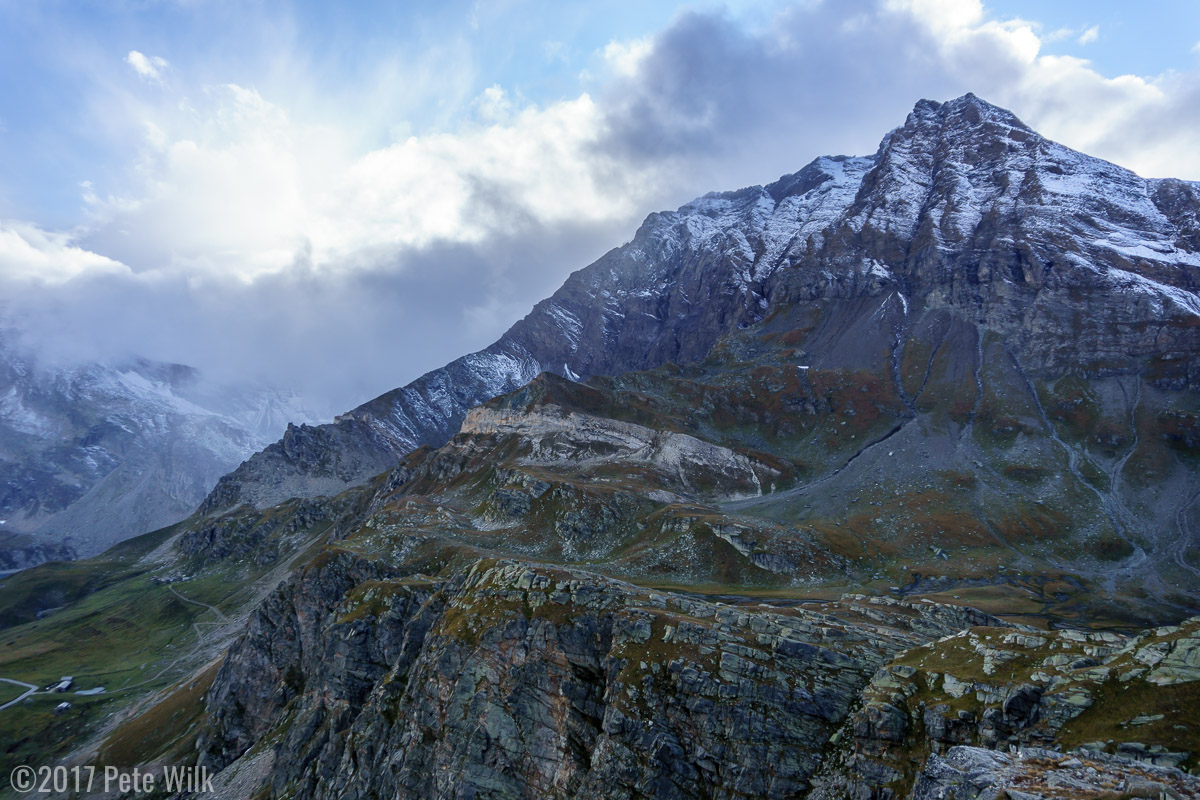
At the top of the pass we looked into the other side of the valley as few flakes flew through the air. I decided that the Kangoo’s lack of ABS and shitty tires meant we should get to lower elevations where snow wouldn’t be falling, plus we’d reached the high point of the valley and it seemed logical to head back. We headed back down valley with the intent to sleep lower down in the valley and perhaps climb at another crag. This plan however didn’t come to pass. Each of the small villages lower down than Ceresole were nearly boarded up. As our plan turned from place to stay to just place to eat, we did stop at one area with what looked to be an open restaurant. At closer inspection we saw a bunch of employees or at least local residents chatting around an otherwise closed up restaurant. We contemplated our potential dinner of Probars as we got back in the car. Luckily the way back brought us through Ivrea, which is a city. Here we were able to find a pizza restaurant and get some pretty darn good pizza. We arrived back in Chamonix around 11pm or so I think.
Tuesday the 19th, we visited the office as I had a few last minute things to attend to as well as drop off the van. We were also able to coordinate dinner plans with Robert for that evening. Since our first choice of restaurant was randomly closed (hooray French culture!) we went to the same place we went on our first night. It was a fitting end to a great trip. I’m already thinking of next time.



